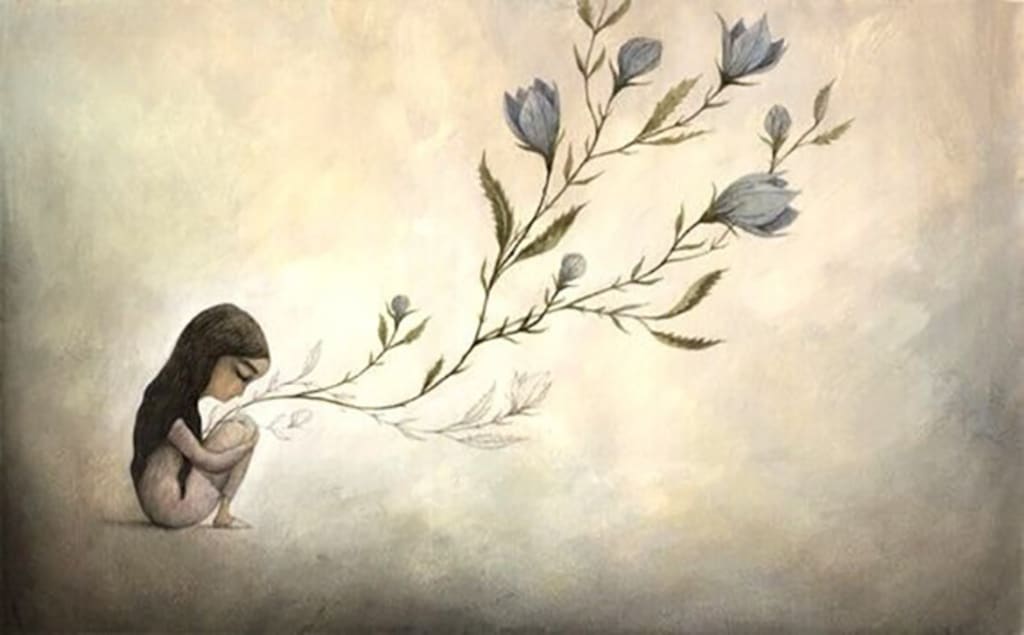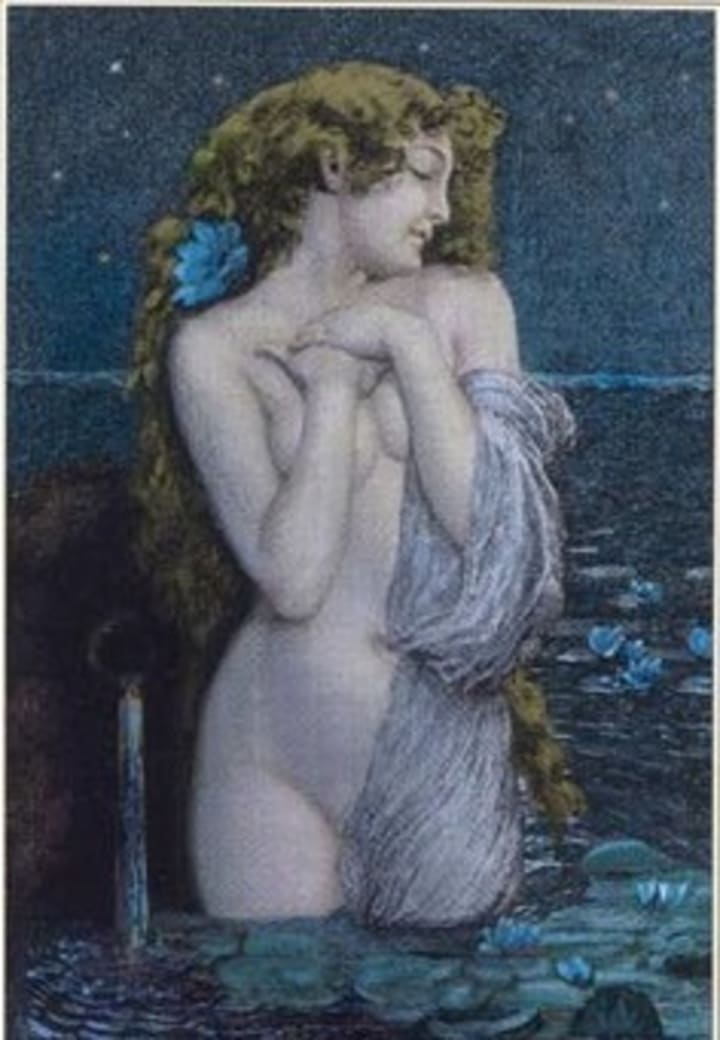Pain Is a Catalyst for Joy
At Least Existentially

A few years ago, I found myself in my apartment bedroom crying on the floor. I was looking out of my window, up at the moon and wondering why my life was falling apart. I felt grief and sorrow, as if someone had died, but the truth was that several parts of me were dying that night. That was the week in between me breaking up with my ex-fiancé of three years and me quitting my job which I found to be soul-sucking and very unethical. Yet looking back, there have been several times where I have thought to myself: "That time in my life was one of the best things that could have ever happened to me." I have genuinely felt grateful from the bottom of my heart for having gone through that experience. Even though it was gut wrenching when I lived though it, it was one of the most liberating moments of my life!
“The greatest magic is in the transformative moments: the heartbreak, the uncertainties, the pause before we hit the ground... and what we do with ourselves after we land.” —Dragonsong, E
Life taught me how to let this pain become a catalyst for me. It catapulted me into my spiritual path and that is why I am who I am today. You see, up to that point I had tried to force myself to conform to the religious norms and world-views of Christianity—many of which, by the way, offended me to the core—Yet, I held onto it out of fear, out of programming, out of fearing the unknown. After all, that is all I had ever really known up to that point. Yet I also held onto to something that was clearly not compatible with me anymore, out of fear of not being loved by someone in whom, I had almost lost myself completely.
After we broke up, I finally gave myself permission to be ME and to explore all of the things that rang true to my heart and that I had withheld from for so long. From the very beginning of this journey, I came across these two quotes:
“Your task is not to seek for love, but merely to seek and find all the barriers within yourself that you have built against it.”—Rumi, J
“And the day came when the risk to remain tight in a bud was more painful than the risk it took to blossom.”—Appell, E
These quotes spoke to me deeply and were almost like clear cut instructions as to how to carry out with my process moving forward. And it all had to do with dealing with my pain, my brokenness—not just the surface wounds from my broken engagement, but from my whole life. Time and time again in Reiki treatments, in my own meditations, in readings with shamans, etc., I got the same message over and over again: In order to reach the light, one must shed the density one carries. How could I open to receive the blessings from God and Divinity if I was so fervently holding onto the past? I found that you must let go and empty your hands and then your hands are free and open to receive. And so, I did that. (At least to some degree anyways, it’s still a work in progress.)
This process described above is what I call the process of blooming and it is painful, just like E. Appell said. However, the key is to embrace this fact and surrender to what is unfolding. Not, running away from it, but wading through it until you find a way to transmute what you are struggling with and heal it.
Yet, we are all programmed NOT to do this. Isn’t our motto as a nation “Life, liberty and the pursuit of happiness?”—It’s NOT: The pursuit of wallowing in a stew of poo… So why would I even want to do this? Why subject myself to the pain?—I do so, BECAUSE RUNNING AWAY DOES NOT WORK. It only makes matters worse. Frida Kahlo, who had an intimate relationship with pain, as was evident through her art work and her writing, once said:
“By putting walls around your suffering you risk letting it devour you from the inside.”—Kahlo, F.
…So, I had no choice but to move forward. I had to wade through the dark first to reach the light. Step by step, I worked on removing all those obstacles and barriers that stood in the way of love and that kept me from realizing my full self.
In a false misconception of self-preservation, we all tend cower away from the things that we need to face, the things that cause us pain. I know I do! Avoidance and denial become automatic coping mechanisms and tactics that we use to avoid dealing with what we perceive as being unbearable.
“Experiential avoidance (EA) has been broadly defined as attempts to avoid thoughts, feelings, memories, physical sensations, and other internal experiences—even when doing so creates harm in the long-run. It is associated with substance abuse, eating disorders, pathological gambling, internet addiction, excessive worry, over-exercise, depression, anxiety disorders and PTSD… to name a few."
So, what happens when your ultimate goal is “to just be happy?” For one, you begin to negatively evaluate any other emotion, as if that emotion is wrong or pathological. The initial response is to avoid that experience—and the long-term consequences of avoidance directly impact your ability to tolerate distress. Minor challenges become overwhelming. Paradoxically, those who face suffering understand that emotions are temporary and learn to accept this as part of the human experience. Within acceptance comes tolerance. The more we face the distress the less intense the emotional experience. In the long run we gain perspective and understand how experiencing the pain of life also enhances the joyful experiences.”—McFillin, R. K., Psy. D. ABPP. (2015, February 25).
A study named "Measuring Experiential Avoidance: A Preliminary Test of a Working Model" which was published by The Psychological Record on October 2004, reached these same conclusions after studying over 2,400 participants. “As expected, higher levels of experiential avoidance were associated with higher levels of general psychopathology, depression, anxiety, a variety of specific fears, trauma, and a lower quality of life.”—Hayes, S. C., Strosahl, K., & Wilson, K. G. (2004).
Carl Jung put it best, when he said:
“People will do anything, no matter how absurd, in order to avoid facing their own souls… - All because they cannot get on with themselves and have not the slightest faith that anything useful could ever come out of their own souls.”—Jung, C. G. (1968).
It is my belief that being so at odds with ourselves eventually causes a deep sense of disconnection and that is what causes the self-perpetuating cycle of experiential avoidance. This cycle can potentially be far more detrimental than what little temporary solace this misleading defense mechanism could provide.
Cowering away from that which we need to face, is in fact what keeps us there, wallowing indefinitely, in that stew of poo… until life's lessons get so big that you either can't keep ignoring them or the walls you have built, finally get torn down. That is why entering the process of reviewing the pain within oneself voluntarily, open-heartedly, however vulnerable you might feel is what's best. By doing so you cease to invalidate your own soul. When we are willing to be vulnerable, that is when we are the bravest. It takes guts to be real and expose one-self, be vulnerable and take risks. Yet, that is when we make the most profound breakthroughs. I have found that it is often those situations that we avoid the most and that we have an aversion to, or that bring up the most pain, that we MUST confront. We need to, for our own sake. Those situations must be faced, resolved, and healed, IN ORDER to get exactly that which we need to obtain in life. Doing so unlocks the door, removes the blocks, and makes it possible for us to triumph.
So, are you scared that if you were to do that, you will break down, and the whole world would cease to exist? Are you petrified that everything that you have tried so hard to control will suddenly crash?... Well, I’d say that sometimes building that much pressure around something, makes the crash inevitable… And sometimes you need to break down to break through, and break free. Thing is, once you have knocked down enough barriers within yourself and seen yourself as worthy enough to stick it through and work through things, the strength and resilience that comes from that self-validation and self-care is strong enough to overcome whatever fears once held hold of you, before. The result is that you are now able to open up to a new life. You open to love and a new paradigm of being.
"The growth of the mind is the widening of the range of consciousness, and … each step forward has been a most painful and laborious achievement."—Jung, C. G., & Jaffe, A
I committed myself to my healing and to my spiritual path in every single possible way I could. I joined reiki circles, received Ru-Hun therapy, learned tarot on my own, worked with Shamans, received Deiksha regularly, and explored all sorts of spiritual paths. I seriously went all out! Yes, I have gone through SEVERAL lessons where I had to learn the hard way and have experienced things that most people spend their whole lives building a safe little cocoon around themselves; to avoid ever having to go through. I’m kind of a slow learner, yet, I have also experienced sheer bliss that would have not been possible, had I not been willing to go on this journey of self-restoration.
Wounds that I carried with me since childhood were lifted and I could mend my relationship with my parents. We went from almost being near-strangers who could not understand each other, to people who love each other’s company (though we still get testy at times) and my mother is now my true confidant who I adore. I am no longer a cynical, skeptical and bitter person who spews negativity. Now, I’m just snarky. Yet beyond these personal strides that I have made, I have experienced transcendental breakthroughs and have found my purpose. I have had ecstatic experiences where I felt at one with the Universe, with all of creation, with God. I have felt grace radiating through me. I have been able to channel that grace towards helping people in need. I have felt my heart shed layers of grime and begin to shine with purpose, love and with a renewed light that I would have never been able to obtain before, back when I was fervently holding on to what was familiar and toxic to me.
To better illustrate my point through imagery, I will share with you how these universal life lessons, in particular, are represented within the Tarot.
“Tarot is a practice rich with history and cultural knowledge… Through its development, tarot cards have absorbed the wisdom, the narratives, the philosophies, the cultural anthropology and the moral lessons of many societies, many religions and many schools of thought. It represents the spectrum of human archetypal conditions and personalities, which can be used by the modern-day practitioner for psychological projective evaluation. Tarot helps us look within ourselves to understand our emotions, the reasoning behind our words and conduct, and the source of our conflicts” - Wen, B. (2015).
Consider the following three cards from The Victorian Romantic Tarot—Tarot Deck—Ukolov, A., & Mahony, K. (2006). Even if you are a skeptic when it comes to Tarot, it does a really good job at illustrating a point that I'm trying to get across, so bear with me...
The Nine of Swords is the personification of fear itself. In the Victorian Romantic Tarot you see girl who is sleepwalking on a rooftop, completely unaware, that she is on the ledge and putting her very life at risk. That is what fear does. It acts as a blindfold that we must remove, in order to be free to live our lives by our convictions, by our own determination and our hearts. Yet, this article is not about fear, it’s about a catalyst for healing and joy. And that’s what brings me to the next two cards that I would like for you to consider:
1. The Tower, (from the same Victorian Romantic Tarot) looks like two men who have been shipwrecked and have barely survived the storm. This card is about cataclysmic and catalytic change. It depicts those moments in life where we feel like everything has fallen to pieces. Yet the point of having to go through that drastic upheaval is because it is a necessary shake-up for things to change. Yet, ironically, the very next card in the deck is The Star. It's immediate succession indicates the link and connection between the two cards. The Star card is about health and healing; finding hope and optimism. It is the dawn of better times where you can find peace and serenity. It is a time of restoration, self-love and renewal.
The Tower and The Star, when interpreted together, address what actions you need to take to fully blossom into wholeness. You are going to have to go through some upheavals in your life and it will be painful at times; but you have to realize that pain is a catalyst for joy. A catalyst brings up what is hurting, it brings up suffering and sorrow. Yet, if you let it be cathartic—understanding and awareness can come about, too. Then comes acceptance, then release and then A FLOOD OF LOVE and Light. And from that comes a new awareness. You have now broken out of your old paradigm. You are no longer limited by what held you to that pain and suffering, because you are letting it go! You are stepping into a new place that offers new freedoms, new energy, new purity of soul and more opportunities to anchor JOY in your life... All because you were willing to move through the feelings of sorrow, find the meaning behind it all and release your grip on the past. That’s what the Tower and The Star together mean for you.
The process described above, bares striking similarity to what psychologists know and have identified as the grieving process. Though grief is often associated with loss, it is most certainly a form of existential pain.
“Grief reaction is a universal and potentially harmful human experience. The English language reflects these realities. ‘Grief' comes from the Latin gravis, meaning ‘heavy,’ and ‘bereavement’ comes from the Old English, meaning ‘robbed.’ A widow or widower has experienced a heavy robbery that has a profound impact on the sufferer's physical and mental health.
A variety of clinical studies have identified factors common in grief. Some descriptions are general, and some provide great detail. For example, Kreis and Pattie describe grief as a three-"stage" phenomenon:
Shock, suffering and recovery.
Which, can be further broken down as we see through this stage scheme for Shock Disorganization:
- Denial
- Searching behavior, emotional components, desolate, pining, despair, guilt anxiety, jealousy, shame. Protest and/ or aggression.
- Letting Go
- Resolution
- Acceptance
- Reintegration”
—Dean, J. C. - Ramsay and Noorbergen (summer 1988).
What I find hopeful is that both mystics and scientists concur on the fact that in the end, once can find not only resolution but also be able to overcome and recover when dealing with emotional pain and grief. If we treat pain as a catalyst, then growth becomes inevitable.
References
Jung, C. G., & Jaffe, A. (19962). Memories, Dreams, Reflections. London: Collins
Appell, E. (Ed.). (2013, March 5). Who wrote “Risk”? Is the mystery solved? Retrieved August 6, 2017, from http://anaisninblog.skybluepress.com/2013/03/who-wrote-risk-is-the-mystery-solved/
The Anais Nin Blog
Dragonsong, E. (n.d.). Akilandashvari - The Goddess Never Not Broken. Retrieved July & Aug., 2017, from http://www.wicca-spirituality.com/akhilandeshvari.html
Rumi, J. (n.d.). Jalaluddin Rumi - Quotes. Retrieved from https://www.goodreads.com/author/quotes/875661.Jalaluddin_Rumi
Goodreads
Kahlo, F. (2015, September 16). 16 Quotes from the Fabulous Frida Khalo. Retrieved from https://exploringyourmind.com/16-quotes-fabulous-frida-kahlo/
Exploring Your Mind
McFillin, R. K., Psy. D. ABPP. (2015, February 25). The Paradox of Avoiding Emotional Pain. Retrieved August 2, 2017, from http://www.centerforibh.com/blog/the-paradox-of-avoiding-emotional-pain/
Center for Integrated Behavioral Health
Hayes, S. C., Strosahl, K., & Wilson, K. G. (2004). Measuring experiential avoidance: A preliminary test of a working model. The Psychological Record, 54, 553-578. Retrieved August 2, 2017, from http://opensiuc.lib.siu.edu/cgi/viewcontent.cgi?article=1359&context=tpr
Jung, C. G. (1968). Psychology and Alchemy (2nd ed., Vol. 12, Collected Works). London: Routledge.
Wen, B. (2015). Holistic Tarot. Berkeley, CA: North Atlantic Books.
Ukolov, A., & Mahony, K. (2006). Victorian Romantic Tarot (1st ed.). Prague: Magic Realist Press.
Maridueña Temple, E. V. (n.d.). Serendipity At Play. Unpublished.
In the Editing Phase
Dean, J. C. (summer 1988). Grief and Attachment. Journal of Religion and Health, 27(2), 157-165. Retrieved August 3, 2017, from http://www.jstor.org/stable/27505968



About the Creator
Elyssa Maridueña
Raised in Ecuador and Mississippi- she is a dichotomy of sorts. Her work history covers everything from human services, to teaching ESL and reading tarot. She's wildly bohemian at times, loves to frolic, bring joy to others & to write.






Comments
There are no comments for this story
Be the first to respond and start the conversation.